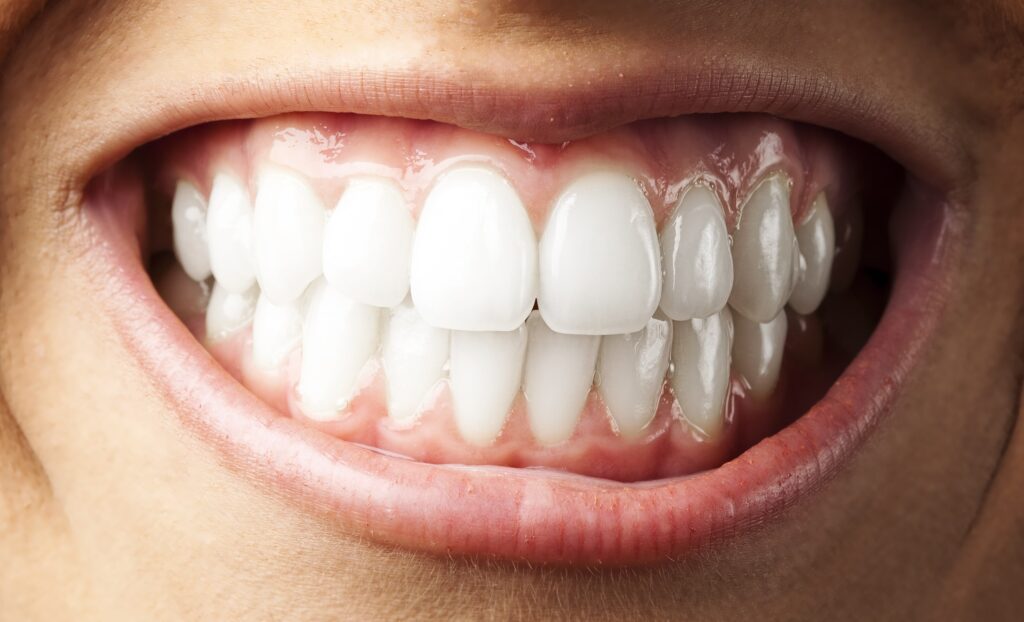When you think about a bite, you likely think about chewing and eating. But “bite” also refers to the way in which your upper and lower teeth fit together inside your mouth. Unfortunately, many people are born with an imperfect bite. For some people, this isn’t a big deal. For others, a bad bite — also known as a malocclusion — can lead to jaw pain, excessive or uneven tooth wear, muscle problems, headaches, embarrassment, self-consciousness, and more. So, you might wonder, how is your bite supposed to look?

The Perfect Bite
For good oral health, teeth should fit together in a very specific way. Dentists and orthodontists evaluate patients’ bites by looking at them from three different angles: the front, the side, and the full arch. How is your bite supposed to look? Oral professionals look for the following details:
- When looking at the front of your bite, the edges of your top teeth should follow the curve of your bottom lip. About 50-90 percent of your bottom teeth should be visible. The upper midline of your teeth (the line between your two front teeth) should line up with the middle of the upper lip, and the lower midline should line up with the top midline.
- When looking at your bite from the right or left side, your teeth should fit together like cogs in a wheel. The pointed ends of the upper teeth should fit perfectly between the two teeth below it. The upper teeth should sit slightly in front of your lower teeth, gently in contact.
- When looking at the full arches, which is what you see when you open your mouth widely and look at your full set of top teeth or bottom teeth, each tooth should be touching the one next to it with no visible space in between, creating a smooth arch of teeth.
A properly aligned bite doesn’t just make for a beautiful smile; it also improves your oral health. How? It reduces your risk of excessive wear, tooth decay, gum disease, jaw problems, and more.
Types of Malocclusions
Now that you know how a healthy bite looks, let’s review some common malocclusions.
- Openbite: The upper and lower teeth do not overlap in the front, leaving a gap in between.
- Underbite: The upper front teeth sit behind the lower front teeth.
- Crossbite: Some upper teeth sit behind the lower teeth, but not all.
- Overbite: The upper front teeth fully overlap and hide the lower teeth. While almost everyone has some degree of overbite, if the degree of overlap is too large, it may require treatment. An overbite is also called a “deep bite.”
What causes malocclusions? There are many reasons you might not have a perfect bite: genetics, uneven upper and lower jaw sizes, a mismatch in tooth and jaw size, impacted teeth, missing teeth, extra teeth, a cleft palate, low-quality dental treatments (poorly fitting retainers, crowns, braces, etc.), a jaw injury, an oral tumor, thumb-sucking, and much more.
Malocclusions are typically treated using orthodontic devices like traditional braces or Invisalign. If you believe that you have a malocclusion, it’s important to schedule an appointment with a dentist if you haven’t in a while. Your dentist can help you understand your specific bite, how it may affect your current and future oral health, and the steps you should take next.
At Wilkinson Dental, we offer Invisalign, which is a great option for treating many types of malocclusions. So, if you’re looking for an experienced, reliable, and friendly dentist near Springfield, Missouri, contact Wilkinson Dental today. Dr. Wilkinson and his team will give you the personalized treatment you deserve using state-of-the-art technology. For exceptional and comprehensive dental care, schedule your first appointment today by calling 417-708-0556 or requesting an appointment online. We look forward to hearing from you!